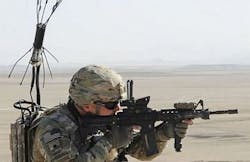RF jammers for the electronic warfare (EW) battle against IEDs go into full-rate production
Officials of the U.S. Naval Sea Systems Command in Washington announced a $57.7 million contract Monday to the Northrop Grumman Mission Systems segment in Herndon, Va., for full-rate production of the Joint Counter Radio-Controlled Improvised Explosive Device (RCIED) Electronic Warfare, Joint Crew (JCREW) Increment One Build One (I1B1).
This contract has options that could increase its value to $505.3 million. CREW systems provide combat troops protection against RCIEDs, and are designed to provide protection for foot soldiers, vehicles, and permanent structures, Navy officials say.
The JCREW I1B1, formerly known as JCREW 3.3, is the first-generation system that develops a common open architecture across all three capabilities and provides protection for worldwide military operations, officials say.
This integrated design makes the most of commonality across all capabilities, reduces life cycle costs, and provides increased protection against worldwide threats, Navy officials say. It is for the U.S. Marine Corps, Navy, and Air Force, and is under supervision of Naval Sea Systems Command.
Among the JCREW I1B1 systems is the Northrop Grumman Freedom 240 for Counter Radio-controlled IED Electronic Warfare Marine Expeditionary Unit Special Operation Capable (SOC), or CREW MEU.
The system jams a wide range of improvised explosive devices (IEDs) and creates a protective barrier around Marine Corps infantry and their equipment while minimizing disruption to friendly communications systems.
On this contract Northrop Grumman will do the work in San Diego and in Sierra Vista, Ariz., and should be finished by August 2022. For more information contact Northrop Grumman Mission Systems online at www.northropgrumman.com, or Naval Sea Systems Command at www.navsea.navy.mil.
Learn more: search the Aerospace & Defense Buyer's Guide for companies, new products, press releases, and videos
